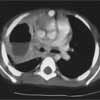What’s Wrong With This Picture? Child With Fever and Persistent Cough
A2¹⁄₂-year-old child is hospitalized with a 1-monthhistory of worsening persistent cough. She was initiallytreated with a 5-day course of oral amoxicillin, andher symptoms abated somewhat. However, for the pastweek, she has experienced high fever (temperatures upto 38.3°C [101°F]) and chills associated with right-sidedpleuritic chest pain.

A 2½ -year-old child is hospitalized with a 1-monthhistory of worsening persistent cough. She was initiallytreated with a 5-day course of oral amoxicillin, andher symptoms abated somewhat. However, for the pastweek, she has experienced high fever (temperatures upto 38.3C [101F]) and chills associated with right-sidedpleuritic chest pain.
The child was delivered at full term with no complicationsand has had normal developmental milestones.There is no history of contact with ill persons (includingthose with tuberculosis). She has had no recurrentinfections, earache, hemoptysis, dyspnea, rash, lymphadenopathy,or ankle edema. There is no history of vomiting,diarrhea, abdominal pain, seizures, urinary symptoms,or bleeding. She takes no medications regularly.She has lost more than 2.72 kg (6 lb) in the past month.The child's father is a smoker; the rest of the familyhistory is noncontributory.
Examination. This well-nourished child looks illand is in moderate respiratory distress. Heart rate is 125 beats per minute and regular; temperature, 38.3°C(101°F); respiration rate, 30 breaths per minute; bloodpressure, 98/62 mm Hg. She is well hydrated. Examinationof the head and neck shows no icterus, erythema,or evidence of candidal infection. Chest movements aresymmetric and equal bilaterally. The trachea is centrallylocated and resonant to percussion. Harsh vesicularbreath sounds are audible bilaterally with coarse ralesover the right, middle, and lower zones. The jugularvein pulse and apex impulse are normal. Heart soundsare normal. Abdominal examination reveals no organomegalyor tenderness. Results of the neurologic examinationare unremarkable.

Laboratory studies. White blood cell (WBC) count,33,600/µL, with 84% segmented polymorphonuclear leukocytes,13% lymphocytes, 1% basophils, 1% eosinophils, and1% monocytes; hemoglobin level, 11.9 g/dL; platelet count,719,000/µL; erythrocyte sedimentation rate (ESR), 110mm/h. Urinalysis results are normal. Blood urea nitrogenlevel, 3 mg/dL; creatinine, 0.3 mg/dL; serum sodium, 134mEq/L; potassium, 4.2 mEq/L; chloride, 98 mEq/L; bicarbonate,24 mEq/L. Blood glucose level, 103 mg/dL. AnECG shows sinus tachycardia.
Chest films are ordered.
Based on the clinical picture and radiographic findings,the most likely cause of the patient's illness is:
- Lung abscess
- Pulmonary coccidioidomycosis
- Sequestrated lung
- Cystic lung disease
- Pulmonary adenoma

OVERVIEW
A lung abscess can be an acute or chronic infection;it is marked by a cavitary lesion containing purulent material.The abscess results from inflammation, suppuration,and necrosis of the involved lung parenchyma. Uncommonin clinical practice today, lung abscess occursat a rate of 1.3 per 10,000 hospital admissions. It can developin a child of any age, although it is rarely seen inneonates. The male-to-female ratio is 1.6:1.
PATHOGENESIS
Pathogens can reach the lungs via the airways orthe bloodstream, or they can spread from a contiguousinfection or traumatic injury.
Primary lung abscess is caused by bronchogenicspread to the lungs, commonly from aspiration oforopharyngeal secretions and resulting necrotizingpneumonia. Secondary lung abscess results fromhematogenous spread, as in bacteremia, endocarditis, orsuppurative thrombophlebitis.
MICROBIOLOGY
Organisms implicated in lung abscess include bacteria,fungi, and protozoa. Most infections are polymicrobialand contain a mixture of anaerobes and aerobes.The common anaerobes are microaerophilic Streptococcus,Fusobacterium, Bacteroides, Prevotella, and Veillonellaspecies. About half of cultures will reveal aerobes,particularly Staphylococcus aureus; Streptococcus pyogenes;group B streptococci; or Gram-negative bacilli,including Klebsiella pneumoniae, Escherichia coli, Haemophilusinfluenzae, and Pseudomonas aeruginosa. In immunocompromisedpatients, culprit organisms includeNocardia, Cryptococcus, and Aspergillus species and atypicalMycobacterium avium-intracellulare or Mycobacteriumkansasii. In certain areas, coccidioidomycosis, histo-plasmosis, and blastomycosis may cause acute or chroniclung abscess.
DIAGNOSIS
Suspect lung abscess when a child has prolongedhigh fever, cough with tachypnea, a toxic appearance,and bronchial breathing.
bronchial breathing.A chest radiograph will show a cavity with or withoutan air-fluid level. The most frequent sites of involvementare the posterior segment of the upper lobe andsuperior segment of the lower lobe, especially on theright.
Ultrasonography of the chest may show a hyperechoicring shadow and help localize the lung abscess.However, chest CT is the most effective means to localizethe abscess precisely, define its size, and guidedrainage or needle aspiration. Sputum should be examinedwith smear and culture for bacteria, fungi,and mycobacteria.
Bronchoscopy may be needed if the patient doesnot respond to antibiotics or if a tumor or foreign bodyis suspected. An ideal specimen can also be obtainedfor appropriate culture by this route.
Ancillary tests, including blood cultures, are warrantedif hematogenous spread is suspected. Typical resultsinclude an elevated WBC count and ESR, and mildanemia.
MANAGEMENT
Antibiotics are the mainstay of therapy and are initiatedas soon as adequate specimens are collected forculture.
The choice of antibiotics is usually empiric. In childrenin whom aspiration is a likely predisposing event,anaerobic coverage is essential. High-dose penicillin orclindamycin is recommended. Alternatively, metronidazolemay be used in combination with penicillin. Otherchoices are
-lactams with
-lactamase inhibitors (ampicillinwith sulbactam, piperacillin with tazobactam, ticarcillinwith clavulanate), imipenem, and chloramphenicol.Once culture and sensitivity data are available, therapyis directed at specific pathogens.
No specific guidelines for the length of antibiotictherapy exist. It is reasonable to use parenteral antibioticsuntil the child is afebrile; oral therapy can then beinstituted. The initial response to therapy usually takesseveral days; symptoms resolve completely within 1 to3 weeks.
Children with lung abscess usually do well with antibioticsalone. However, if clinical deterioration occursdespite appropriate therapy, more aggressive measuresmay be necessary. These include drainage via bronchoscopyand percutaneous tube drainage. Percutaneousneedle aspiration and wedge restriction or lobectomymay be required in extreme cases, such as rapid expansionof the abscess associated with mediastinal shift.
References:
FOR MORE INFORMATION:
Asher MI, Leversha AM. Lung abscess. In: Chernick V, Boat TF, Kendig EL,eds. Kendig’s Disorders of the Respiratory Tract in Children. Philadelphia: WBSaunders Co; 1998:552-559.
Brook I. Lung abscesses and pleural empyema in children. Adv Pediatr InfectDis. 1993;8:159-165.
Powell KR. Primary pulmonary abscess. Am J Dis Child. 1982;136:489-496.
Newsletter
Access practical, evidence-based guidance to support better care for our youngest patients. Join our email list for the latest clinical updates.